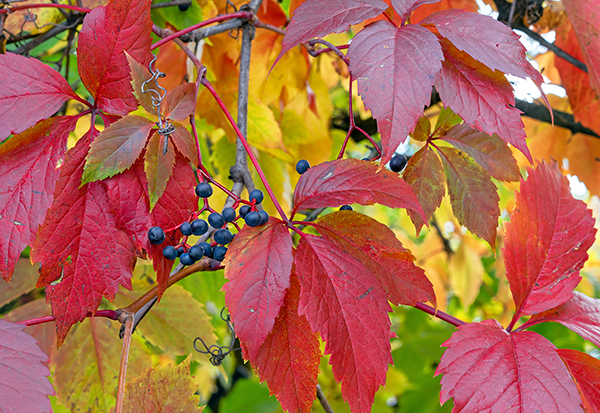
By Terry W. Johnson
Attracting songbirds on their fall migration to your backyard is always a challenge. Some folks have limited success feeding them fruit. However, if you want to host a wide variety of these migrants, you need to offer them a bountiful supply of native fruits and berries.
Weeks ago, birds such as warblers, thrushes, tanagers and flycatchers began making preparations for their fall migration by switching their diet from one rich in insects to one dominated by berries and fruits. Before they leave on their epic journey, they will increase their body weight anywhere from 50-100 percent.
But these birds do not gobble up just any berry or fruit they find. Instead, they show a definite preference for berries that are highly pigmented (such as blue, blue-black and red) and produced by native plants. Some non-native plants produce berries that are similarly colored; however, these berries are often far less nutritional. This is important to the birds because they are on a tight time schedule. They need to spend as little time as possible bulking up. Eating berries that are higher in nutrients allows them to reach the desired body weight in the shortest time.
Researchers have recently learned that strongly pigmented berries are high in antioxidants. In fact, some biologists believe the birds’ preference for these berries is linked more to the antioxidants they contain than to their sugar and fat content. Antioxidants help the birds deal with the stress of long migrations. In addition, the plants bearing such berries often advertise their presence with brightly colored foliage or stems.
Since the fall songbird migration takes places mostly at night, literally thousands of tanagers, flycatchers, warblers, thrushes, vireos and other songbirds pass over Georgia under the cloak of darkness. The only time we see them is when they make a periodic stops to rest, drink and eat. How long they stay depends on factors such as the weather, their physical condition and the availability of water and food. Sometimes their stops last a day or two. Sometimes the birds linger much longer.
This is where we can help them. If our yards provide these amazing long-distance travelers with the native berries they need to refuel and continue on their journey, they can more quickly resume their flight, while also providing us with the chance of seeing scores of birds most of us probably never imagined we would see in our yard.
The first thing homeowners should keep in mind is that the fall songbird migration actually begins in summer. Much of it is over before autumn. For example, most of the beautiful small orchard orioles that have been singing in our yards this spring have already left for their winter homes, anywhere from central Mexico southward to Panama. Many of the thrushes and vireos also are already on the move. However, late summer and early fall is when a greater variety of flycatchers and thrushes is passing through.
Consequently, we need to provide plants that are cloaked with an abundance of native fruits and berries from August into the fall. Here is a short list of six of these plants.
First is Devil’s walking stick (also called Hercules’ club). This plant grows upward of 15 feet tall. It is named for its unique stems covered with spiny thorns and produces a crop of black fruits borne on pink stalks. These fruits are eaten by a number of resident birds such as mockingbirds and migrants such as American robins and gray catbirds. A word of caution, though: This plant can spread and often needs to be controlled.
Next up: possumhaw. This native shrub grows 15-30 feet tall and produces an annual crop of red berries that are eaten by a number of migrants such as thrushes.
Flowering dogwood is one of the iconic small trees of the South. Its shiny red berries are loaded with fat. Some 75 species of birds, including many migrants, eat the berries of flowering dogwoods.
Pokeberry is a perennial that can attain a height of 20 feet or more. Its purplish, juicy black berries, displayed on magenta stems, are consumed by more than 20 year-round resident birds, including mockingbirds and cardinals, as well as southbound migrants.
Virginia creeper is a vine that produces an abundance of bluish-black berries that are gobbled up by about 35 species of birds, including migrating warblers, thrushes, tanagers, grosbeaks, catbirds, vireos and others. While this is a valuable songbird food plant, do not recommend planting Virginia creeper near a building: It has a propensity to climb any structure. However, it does well growing on fences, trellises and arbors.
Sassafras is probably a plant that you never dreamed of as being a great source of food for migratory birds. However, the small tree’s blue-black fruits are among the most nutritional foods available to migrants. Species that eat them include eastern kingbirds, vireos, great crested flycatchers and gray catbirds.
I hope you can find places for these plants in your yard. If you do, you will be bringing more wildlife to your home while enhancing the definition of “bird feeding.”
Terry W. Johnson is a former Nongame program manager with the Wildlife Resources Division and executive director of The Environmental Resources Network, or TERN, friends group of the division’s Nongame Conservation Section. (Permission is required to reprint this column.) Learn more about TERN, see previous “Out My Backdoor” columns, read Terry’s Backyard Wildlife Connection blog and check out his latest book, “A Journey of Discovery: Monroe County Outdoors.”